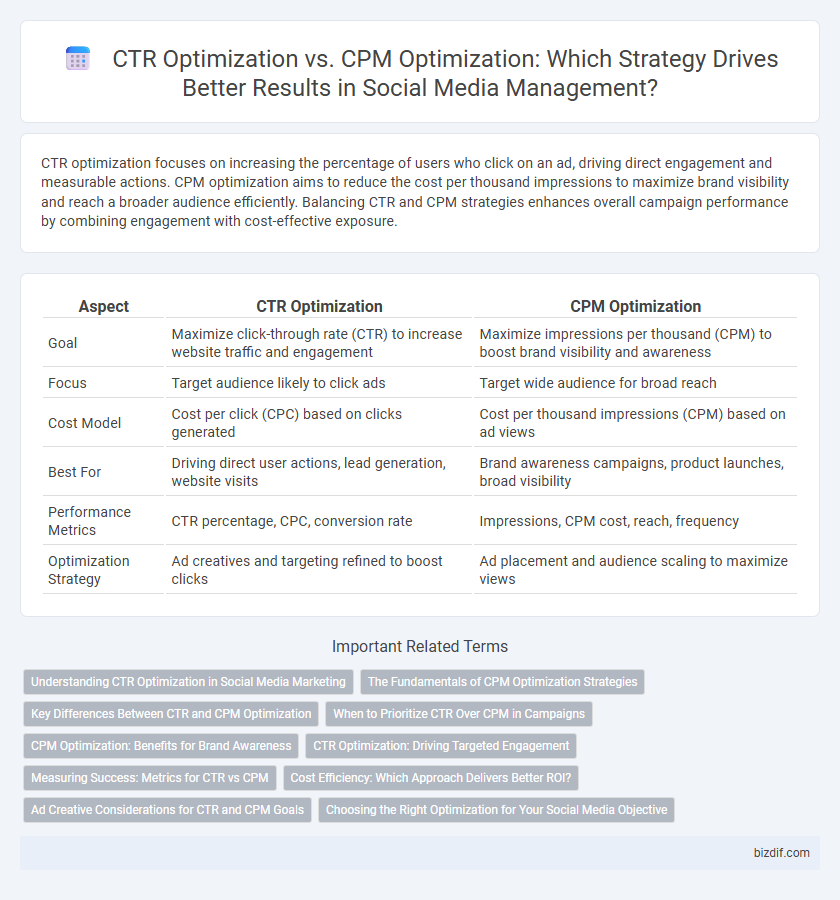CTR optimization focuses on increasing the percentage of users who click on an ad, driving direct engagement and measurable actions. CPM optimization aims to reduce the cost per thousand impressions to maximize brand visibility and reach a broader audience efficiently. Balancing CTR and CPM strategies enhances overall campaign performance by combining engagement with cost-effective exposure.
Table of Comparison
| Aspect | CTR Optimization | CPM Optimization |
|---|---|---|
| Goal | Maximize click-through rate (CTR) to increase website traffic and engagement | Maximize impressions per thousand (CPM) to boost brand visibility and awareness |
| Focus | Target audience likely to click ads | Target wide audience for broad reach |
| Cost Model | Cost per click (CPC) based on clicks generated | Cost per thousand impressions (CPM) based on ad views |
| Best For | Driving direct user actions, lead generation, website visits | Brand awareness campaigns, product launches, broad visibility |
| Performance Metrics | CTR percentage, CPC, conversion rate | Impressions, CPM cost, reach, frequency |
| Optimization Strategy | Ad creatives and targeting refined to boost clicks | Ad placement and audience scaling to maximize views |
Understanding CTR Optimization in Social Media Marketing
CTR optimization in social media marketing focuses on increasing the click-through rate by targeting highly relevant audiences and crafting compelling call-to-action content that drives user engagement. This approach prioritizes user intent and interaction quality, leading to more efficient use of advertising budgets by maximizing clicks rather than just impressions. Understanding CTR optimization enables marketers to measure campaign effectiveness through specific click metrics, ensuring higher conversion potential compared to CPM strategies focused solely on cost per thousand impressions.
The Fundamentals of CPM Optimization Strategies
CPM optimization focuses on maximizing impressions and ad visibility by targeting audiences with high engagement potential, ensuring cost-effective brand exposure. It involves analyzing audience demographics, ad placements, and timing to improve ad relevance and reduce wasted spend. Effective CPM strategies prioritize impression quality over direct clicks, enhancing overall campaign reach and awareness.
Key Differences Between CTR and CPM Optimization
CTR optimization focuses on increasing the percentage of users who click on an ad, enhancing engagement and driving direct user actions, while CPM optimization aims to maximize ad impressions per thousand views, prioritizing brand awareness and reach. CTR metrics are vital for campaigns targeting conversions and user interaction, whereas CPM is ideal for broad visibility and frequency goals. Understanding the distinct objectives of CTR versus CPM optimization enables marketers to tailor strategies for performance-based outcomes or widespread audience exposure.
When to Prioritize CTR Over CPM in Campaigns
Prioritize CTR over CPM in campaigns aiming for direct engagement and conversions, as a higher click-through rate indicates more user interaction per impression. CTR optimization is crucial when the goal is to drive traffic to landing pages, enhance lead generation, or increase app installs. Focus on CTR when targeting specific audience segments where user intent and active responses are key performance indicators.
CPM Optimization: Benefits for Brand Awareness
CPM optimization maximizes brand visibility by targeting impressions, ensuring ads reach a broader audience and increasing overall exposure. This approach is cost-effective for campaigns aiming to build brand recognition rather than immediate clicks or conversions. Brands leveraging CPM optimization can enhance top-of-mind awareness, leading to stronger customer recall and long-term engagement.
CTR Optimization: Driving Targeted Engagement
CTR optimization focuses on enhancing the click-through rate to drive targeted engagement by attracting users genuinely interested in the content. This strategy improves ad relevance and audience interaction, leading to higher quality traffic and better conversion rates. By prioritizing CTR over CPM, marketers ensure their campaigns generate meaningful clicks rather than just broad exposure.
Measuring Success: Metrics for CTR vs CPM
CTR optimization measures success by the percentage of users who click on an ad, indicating engagement and relevance, while CPM optimization focuses on the cost per thousand impressions, emphasizing brand visibility and reach. High CTR demonstrates effective ad targeting and compelling content that drives user action, whereas low CPM ensures budget efficiency by maximizing the number of impressions for a given cost. Balancing these metrics helps social media managers optimize campaigns for both user interaction and cost-effective exposure, ultimately enhancing overall ROI.
Cost Efficiency: Which Approach Delivers Better ROI?
CTR optimization targets maximizing click-through rates by refining ad creatives and targeting to attract engaged users, often leading to higher quality traffic and better conversion potential. CPM optimization focuses on minimizing cost per thousand impressions, aiming to increase brand visibility at scale but may result in lower engagement if impressions aren't well-targeted. In terms of cost efficiency and ROI, CTR optimization generally delivers superior returns by driving actionable user interactions rather than just broad exposure.
Ad Creative Considerations for CTR and CPM Goals
Ad creative for CTR optimization should focus on compelling headlines, clear calls-to-action, and engaging visuals that prompt users to click on the ad. For CPM optimization, creatives need to emphasize brand awareness with eye-catching designs and consistent messaging to maximize impressions and reach. Tailoring ad formats and content to align with either CTR or CPM goals significantly enhances campaign efficiency and returns.
Choosing the Right Optimization for Your Social Media Objective
Selecting the appropriate optimization strategy depends on your specific social media goals: CTR optimization targets increased user engagement and website traffic by focusing on clicks, while CPM optimization aims to maximize ad impressions and brand visibility by paying per thousand views. Analyzing campaign objectives, audience behavior, and key performance indicators helps determine whether driving direct interactions or raising awareness will yield better ROI. Platforms like Facebook Ads Manager and Google Ads offer robust tools to track CTR and CPM metrics, enabling data-driven decisions for tailored ad spend allocations.
CTR optimization vs CPM optimization Infographic

 bizdif.com
bizdif.com